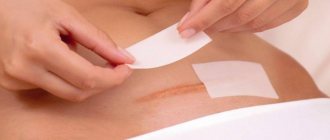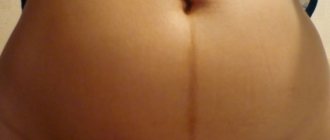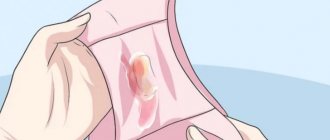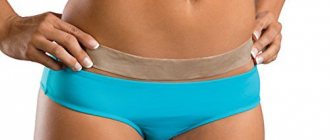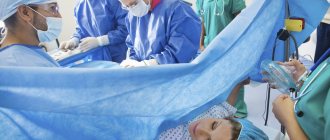Childbirth is a complex and step-by-step process. Sometimes it happens that the birth of a child is only a small part of what the expectant mother has to endure.
Quite often, a gynecologist prescribes cleaning the uterus after childbirth. Patients get scared and wonder why this is necessary. However, everything is not so simple here. This procedure is carried out if the placenta has separated in pieces or has not come out of the uterine cavity at all.
For some women, it is enough to stimulate muscle contractions with oxytocin or other hormones to release the afterbirth. For the rest, there is nothing more reasonable than to carry out vacuum or manual scraping .
What could be the consequences after cleaning the uterus?
The process of scraping a woman’s muscular organ is quite complex. The doctor performs it almost blindly . At the same time, it is not possible to use cameras that would display images of internal organs on the monitor.
That is why sometimes adverse consequences occur , namely:
- introduction of infection;
- development of the inflammatory process;
- endometritis;
- hematometer;
- exacerbation of chronic sexual diseases;
- heavy bleeding.
Normally, after such an operation, bleeding for 5-7 days. However, if they continue longer than the designated period and at the same time become more and more abundant, then this is a cause for alarm.
Serious concerns are also caused by the sharp pain that may accompany bleeding. These symptoms often indicate the rapid development of an acute inflammatory process .
If you ignore these signs and do not contact a gynecologist, you may subsequently lose the opportunity to have children. Untreated endometritis or hematometra often become a reason for complete surgical removal of the uterus. You can avoid negative consequences. To do this, it is necessary to contact your doctor when the first symptoms indicating the presence of a problem occur.
Possible complications
First of all, such consequences include hematometra - a fairly common complication after cleaning in the practice of gynecologists. This condition occurs due to excessive compression and spasms of the cervix itself - blood clots are retained in its cavity. To prevent such a phenomenon, compression of the cervix, and, accordingly, retention of blood clots in its cavity - as noted earlier, doctors prescribe no-shpa or aspirin.
Another complication after gynecological cleansing is uterine bleeding - this negative consequence is quite rare in the practice of doctors, but it is typical for those women who suffer from problems with blood, its ability to clot normally. When bacteria, microbes, or the negative effects of pathogenic microflora enter the uterine cavity, endometritis can develop. At its core, endometritis is an inflammatory process of an infectious nature that affects the uterine mucosa.
When diagnosing any complication, if negative symptoms appear in the form of discharge with pus from the uterine cavity, or an increase in body temperature, you should immediately visit a gynecologist. Only an experienced doctor can help - do not self-medicate.
But during the normal course of the procedure for uterine cleansing of the placenta left after childbirth, a woman may be bothered by pain in the lumbar region and lower abdomen, scanty discharge of blood, reminiscent of menstruation - such symptoms will be observed for 7-10 days. To summarize, we can summarize one thing - the cleaning procedure itself after childbirth is important and not as scary as it might seem at the very beginning. If all the rules of its implementation by doctors are observed, as well as the personal hygiene of the woman herself, no complications are observed in the woman in labor, and her health will be restored in the shortest possible time. And in some situations, you simply cannot do without such a gynecological procedure.
You can share the article with friends via social media. networks:
Does cleaning hurt?
There are no completely painless procedures in medicine. This is an indisputable fact. However, it was not for nothing that anesthesia was invented. The curettage process takes place under local or general anesthesia . Without this, a woman is not able to tolerate such manipulation of her internal organs.
If the doctor sees from the ultrasound results that curettage can be performed under local anesthesia, then he does so. However, the woman still feels some discomfort . As a rule, it all depends on the sensitivity threshold. If it is high, then the patient will feel a little pain. When the pain threshold is low, the discomfort is practically not felt.
If the gynecologist discovers serious damage when it is necessary to perform vacuum instrumental curettage , then he will prescribe general anesthesia. In this state, the woman is freed from the need to endure pain and discomfort. There will be no painful shock . However, after waking up, the patient will still feel that an intervention has been performed. The lower abdomen may hurt and feel tight. For several days after the cleansing, the body temperature remains low-grade.
Contraindications and consequences
Cleaning the uterus after childbirth, like other surgical interventions, cannot be performed if any inflammatory processes occur in the woman’s body, other than those that caused this manipulation.
As a rule, there are no serious consequences of curettage in women. But it is worth remembering that the guarantee of a successful result of this gynecological operation is that it must be carried out in an official medical institution, by qualified specialists.
Most women experience spotting after curettage, which may resemble menstruation. The duration of bleeding is different for everyone, which is determined by the individual characteristics of the body and the rate of regeneration of the mucous membranes. It is normal if blood is released from the vagina for no more than 10 days in moderate quantities and without an unpleasant odor. As during menstruation, the amount of discharge gradually decreases and completely disappears. You may also feel nagging pain in the lower abdomen and lower back.
However, if the surgical intervention was performed incompetently or negligently, then the woman may face consequences such as:
- Bleeding for more than 10 days. The cause may be: tissue remains in the genital organ; if surgery is performed in the middle of the menstrual cycle, hormonal imbalance.
- Tears of the cervix or damage to its walls, with the formation of through defects, occur when the forceps are not firmly fixed due to the low elasticity of the organ. A surgical suture may be applied.
- Hematometra is a disease caused by blockage of the uterine cavity with blood clots due to the closure of the cervical canal. It has the following symptoms: fever, severe pain in the lower abdomen, cessation of natural bleeding after gynecological manipulation.
- Endometritis is an infectious disease caused by the activity of streptococci and other pathogens due to poorly processed surgical instruments and tissue particles left behind. Accompanied by bloody discharge with a pungent odor, pain in the lower abdomen and fever.
- Infertility is the most terrible consequence that can be caused by negligence or insufficient professional qualifications of medical personnel.
After the operation, the following recommendations should be followed;
- avoid intimacy for a month;
- do not use vaginal tampons;
- do not lift heavy objects and avoid excessive physical activity;
- do not take blood thinning medications;
- refrain from visiting the pool, do not steam or take hot baths.
When is the procedure performed without anesthesia?
Many women think with horror about the upcoming cleansing . They vividly and in detail imagine how doctors will mock them. However, it is worth remembering that this is the 21st century. No one will bully people. It is extremely difficult mentally and physically to endure uterine curettage without anesthesia.
If for some reason general anesthesia cannot be performed , then local anesthetics are used. It can be:
- cream;
- gels;
- lidocaine injections;
- sprays.
In no case can this operation be performed without anesthesia. Doctors simply do not have the right to do this. Do not be afraid if the doctor has not prescribed general anesthesia. Before cleaning, the uterus must be numbed with other local medications . At the same time, pain is felt, however, it is not so strong that you tremble and twitch.
With the right psychological attitude, such an intervention can be tolerated. This is not an abdominal operation without anesthesia, but a simple curettage. So there is no need to worry unnecessarily. The gynecologist knows what and how to do.
After discharge
If you are one of the “lucky ones” who underwent cleansing after childbirth (and as you can see, this procedure is not done for all postpartum women, but only in the presence of the complications described above), you will be required to strictly adhere to the rules of hygiene of the postpartum period. They are:
- Wash with warm clean water at least 2 times a day.
- Change gaskets as needed.
- No tampons or douching.
- No saunas, hammams, baths, steam rooms or baths. Only showers are allowed.
- Vaginal sex is prohibited.
- Avoid drafts and hypothermia.
- Postpone strenuous exercise and intense sports for at least 2 months.
- Perform a set of gymnastic exercises for newborns every day.
- The pool, swimming in the river and the sea are also not for you.
- Eat a balanced diet. Preference for protein foods, vegetables and fruits, limitation of fatty foods and simple carbohydrates.
- Take vitamin and mineral complexes for nursing mothers.
I would like to believe that you got rid of the habit of drinking alcohol and smoking at least six months before your planned pregnancy. If not, do it immediately.
Visit your obstetrician-gynecologist 5-6 weeks after giving birth to make sure there are no abnormalities. At the same time, discuss issues of future contraception.
As a rule, even a woman’s hard lot of cleaning the uterine cavity does not greatly overshadow the memories of the wonderful days spent in the maternity hospital and associated with the arrival of the baby into this world. And many then want to return there again and again. And there are no obstacles to this. Yes, even though you had your uterus cleaned after childbirth, if you followed all the doctor’s recommendations, then there should be no problems in the future.
How is curettage done?
Scraping is done using special tools : manual or vacuum.
In both cases, the upper inner layer of the uterus is removed along with pieces of the placenta or the entire placenta. This is done in order to prevent the development of the inflammatory process in the birth canal.
There is no need to worry about the endometrium recovering more. Within a month after curettage, a new protective layer grows .
Cleaning the uterus is performed under general or local anesthesia. A woman sits in a gynecological chair, she is given anesthesia, and her genitals are treated with iodine and a 50% alcohol solution to disinfect. When the anesthesia has taken effect, the doctor begins cleaning. Using special instruments, he scrapes out everything unnecessary from the uterus . At the end of the procedure, the woman is transferred to a hospital, where she undergoes rehabilitation over the next few days.
Benefits of the procedure
As a rule, after the birth of a baby, a woman remains in the maternity hospital under the supervision of doctors for another 5 days, and this is necessary so that the gynecologist can assess the mother’s condition and determine:
- her body temperature;
- condition of the birth canal;
- discharge from the uterus;
- the condition of the sutures (if any had to be placed after a cesarean section or as a result of ruptures);
- general well-being of the woman.
If, 2-3 days after birth, upon visual examination and measurement of the fundus of a woman’s uterus, a weak (or complete cessation) of its contraction is noted, then the doctor may resort to an instrumental examination in a gynecological chair or refer the patient to an ultrasound of the pelvic organs to examine her for possible the presence of placenta particles, membranes or large blood clots in the uterus.
If any are detected, then intravenous injections are first prescribed to stimulate uterine contractions and facilitate the passage of the placenta from the reproductive organ. Such a complication arises in the case of strong fusion of the placenta with the uterus, which does not allow the tissues to come out freely in the second phase of labor. And the presence of foreign tissue in the uterus becomes:
- firstly, it is a breeding ground for microorganisms, and their active reproduction can cause purulent inflammation;
- secondly, the cause of a significant decrease in the contractility of the uterus, which ultimately leads to infection and the development of serious postpartum consequences.
If droppers do not help, then this is an indication for cleaning the uterus, since further development of purulent processes and toxic poisoning of the body as a whole immediately prohibit breastfeeding (since the infection gets into the breast milk through the bloodstream) and threatens the patient’s health .
The postpartum cleansing procedure is usually performed under anesthesia and is technically similar to an abortion after an unwanted pregnancy. To avoid painful shock, both general and local anesthesia can be used. However, when carrying out vacuum cleaning, a woman may not be afraid of getting microtraumas and other similar complications, and therefore the procedure is carried out under local anesthesia - the patient does not feel pain, but may experience characteristic unpleasant sensations for curettage.
The operation takes place according to the following “scenario”:
- Preoperative examination of the woman’s genital organs - their external and internal treatment with antiseptics (ethyl alcohol and iodine)
- Gradual dilatation of the cervix using dilators of different diameters.
- A cleansing procedure during which all blood clots and afterbirth residues are removed. The vacuum is created using special equipment, the operating principle of which resembles the operation of a vacuum cleaner. During the cleansing procedure itself, “everything unnecessary” and the upper epithelial layer of the walls of the organ are removed from the uterus.
The procedure lasts about half an hour.
It may be possible to avoid cleaning after childbirth, but complications that arise when this procedure is not performed in a timely manner are, at best, only one woman out of a thousand.
And even then it is not a fact that long-term complications will not arise, the most dangerous of which is infertility in the future.
Many “well-read” contemporaries do not like the fact that after this manipulation it is necessary to prescribe antibiotics and temporarily stop breastfeeding.
Now, if she herself begins to take antibacterial drugs for a cold, then this is wonderful, but the doctor’s prescriptions and the need to manually express milk to maintain lactation can be ignored.
Only the majority of these young mothers forget that the surface of the uterus after childbirth is a continuous open wound surface, and any blood clot or piece of placenta that remains in the uterus is a foreign body.
It should not be there by definition - firstly, it is an ideal breeding ground for microorganisms, which can cause purulent complications that will still have to be treated, and secondly, it interferes with normal contractions of the uterus, which increases the risk of infection.
We suggest you read: Why there is spotting after sexual intercourse
There is no need to try to hide elevated body temperature, because this symptom occurs not only with congestion in the uterus, but also with inflammation of the sutures (if they were applied), and with an increase in the amount of breast milk produced - in any situation, only a qualified doctor should assess the woman’s condition.
And if, during an examination or based on the results of an ultrasound examination, the doctor finds indications for cleaning, it is better to agree with him and carry out the necessary treatment.
Otherwise, there is a high probability that the young mother will still have to return to the hospital and have endometritis treated, but in this case the baby will have to stay at home, because in the gynecological departments of hospitals there are no conditions for the child to stay and cannot be.
If the normal biological mechanism is disrupted, the separation of the placenta and membranes is disrupted - with a large size of the uterus (overdistension during multiple pregnancy), with placenta accreta, which occurs against the background of pre-existing inflammatory diseases of the uterine cavity and internal genital organs, or against the background of previously performed abortions.
In this case, manual separation of the placenta (manual cleaning after childbirth) is required, after which the doctor (not a midwife, as in the normal course of childbirth) determines the integrity of the membranes and placenta as a whole.
In addition, manual separation of the placenta, but under visual control, like dilatation of the cervix, is necessarily performed during a cesarean section - without this it is impossible to avoid purulent complications in the late postpartum period or in the early period of recovery after childbirth.
That is why a woman remains in the delivery room for the first two hours after the completion of labor - not only her general condition is assessed, but also the degree of blood loss through the birth canal, as well as the dynamics of uterine contraction.
Vacuum cleaning is prescribed if the birth of the baby did not end with the spontaneous release of parts of the placenta and blood clots from the woman’s body. This procedure is necessary, as there is a risk of inflammation and the development of infectious pathologies.
There are several indications for such curettage after labor:
- detection of amniotic sac in the birth canal;
- the need for a biopsy;
- the presence of placenta remains in the uterine cavity;
- heavy bleeding.
The procedure is also prescribed in other cases:
- if there is a need for a vacuum abortion in the early stages of pregnancy;
- defective release of fetal remains during spontaneous miscarriage;
- freezing of the fetal development process.
Vacuum cleaning of the uterine cavity after childbirth has several advantages, due to which it is considered the safest scraping technique. The main advantages of the operation:
- the possibility of early pregnancy termination without damage to the cervix;
- manipulations allow not to damage the walls of the uterus during the operation;
- During the procedure, the woman does not feel pain, as she is given local anesthesia;
- surgery is carried out quickly.
Also, this cleaning technique allows you to reduce the risk of diseases of the reproductive organs, which is why a woman is able to bear and give birth to a healthy baby during her next pregnancy. A minimal amount of mechanical manipulation helps protect the outer part of the genital organs from the formation of cracks.
Vacuum cleaning of the uterus is carried out not only after childbirth, but also during frozen pregnancy.
Curettage of a fetus that has stopped developing is carried out in the case when the woman’s body does not independently reject it. In this case, the vacuum cleaning method for frozen pregnancy is used according to similar instructions.
After the procedure for eliminating fetal remains, an analysis is carried out for histology and the presence of genetic disorders. This is necessary to diagnose the causes of pregnancy loss.
After the operation, the woman must be observed by the attending physician. If alarming symptoms appear, you should consult a doctor to eliminate the possibility of developing pathologies that threaten life and health. Normally, during the postoperative period, pain in the lower abdomen and weakness may be felt. It is also possible for a bloody discharge to appear, which continues for 6–9 days after cleansing.
Vacuum cleaning: distinctive features
This type of curettage is safer , according to some doctors. However, it also causes more pain for the patient. This is why vacuum cleaning is done under general anesthesia and nothing else.
The placenta is sucked out from the uterine cavity using a special device, which in its mechanism of action resembles a vacuum cleaner. Of course, this comparison is a little exaggerated, however, the vacuum cleaning device sucks in the contents of the uterus along with the upper layer of the endometrium.
After such curettage, the doctor must treat the inside of the uterus with an antibacterial solution to avoid contamination and infection . In addition, the woman is prescribed a course of antibiotics that will prevent the development of extensive inflammation of the uterus and appendages.
Technique of the operation
Compliance with these rules allows you to determine the indications for manipulation in a timely manner; cleaning after childbirth will help prevent the development of complications - unfortunately, sepsis after childbirth still occurs today , in the era of widespread use of antibiotics.
In terms of technique, cleaning after childbirth is practically no different from curettage of the uterine cavity during an unwanted pregnancy or manipulation performed for diagnostic purposes.
During the operation, performed under general anesthesia , mechanical removal of the remnants of the functional layer of the endometrium of the uterus, which normally should completely come off during childbirth, as well as blood clots.
Immediately before the manipulation , already on the gynecological chair, a gynecological examination of the woman is carried out and the external genitalia is treated with antiseptic solutions (alcohol solution of iodine, ethyl alcohol of different concentrations).
After this, a gradual mechanical dilation of the cervix is carried out, curettage is performed, during which all clots and remaining particles of the membranes and placenta are removed.
In the absence of complications, the procedure itself usually takes no more than 20-25 minutes, after which the woman is prescribed urethorotonic drugs (drugs that increase the contractility of the uterus).
However, after cleaning the uterus and its successful contraction, the postpartum woman should remain under medical supervision - an adequate assessment of the woman’s body’s reaction to pain medications and bleeding, which necessarily intensifies immediately after the manipulation, is necessary.
Broad-spectrum antibacterial drugs are prescribed
He can opt for a drug that exists in injection form (this part of the therapy will be carried out in a hospital setting) and tablet form - it will be continued to be taken at home.
Manual cleaning after childbirth
When the pieces of placenta that remain in the uterus are small in size, the gynecologist most often prescribes manual cleaning .
Such scraping differs from the version with a vacuum instrument only in the shape and mechanism of action of the device for the operation. As a rule, this kind of intervention is performed using an instrument that has a round loop at the end .
Thus, all foreign bodies that are in the uterus are captured and brought out. After manual cleaning, the doctor always prescribes antibiotics, and for some time the woman should regularly visit the gynecologist. This will protect the patient from negative consequences and complications.
Treatment
Therapy after curettage of the uterine cavity involves taking medications. They do not build up the endometrium, but prevent infection and improve a woman’s well-being. Antispasmodics are prescribed with caution because they promote contraction of the uterus, which is accompanied by severe pain, especially immediately after cleansing. In severe cases, No-shpa is indicated.
Antibiotics are required to be prescribed: they help avoid infection. The vaginal microflora is restored with the help of antifungal agents in the form of tablets and suppositories. You can use herbal decoctions and infusions: shepherd's purse, nettle, boron uterus, viburnum, lemon balm.
Hormonal medications help restore balance in the body and prevent recurrence of the disease.
In addition to the medications listed, they take enzymes that prevent the formation of adhesions.
A prerequisite is an examination by a gynecologist and repeated tests to avoid relapse. There is no point in planning pregnancy within the next six months of treatment. You should have sex after curettage with a condom and only after a follow-up examination by a female doctor.
Curettage after caesarean section
If the birth was not natural, then the placenta is removed during cesarean section . After this, in most cases, no complications arise.
However, situations occasionally occur when the doctor missed several pieces of the placenta. This is a direct reason for prescribing curettage. Only the doctor can decide which form of procedure is best.
However, according to modern statistics, preference is given to the vacuum method. The patient is put under short-term general anesthesia and curettage is performed, which lasts no more than 20 minutes .
How a woman will feel after surgery depends on many factors, namely: morale, medical care, nutrition. It is important to follow all the doctor’s recommendations , and then recovery will not take long.
Concept and reasons
What is postpartum cleansing?
This is a process of intervention by a gynecologist, as a result of which the uterus is freed from pieces of the placenta and blood clots. Basically, vacuum or manual cleaning of the uterus is performed. Curettage using an instrument takes place in situations where the organ is closed.
One of the reasons for cleansing is infections in the body. As soon as the child is born, if there is doubt about the integrity of the placenta, manual manipulation is performed or, when the gynecologist is not sure that the placenta has completely come out. The uterus is cleaned under anesthesia, and the obstetrician removes particles of the placenta.
Why do they cleanse after childbirth:
- the muscles of the uterus contract weakly;
- the placenta is strongly attached to the walls;
- presence of infection in the body;
- abortions were carried out.
Be sure to do cleaning after childbirth during a cesarean section or if the placenta has not passed at all. When placenta accreta occurs, you have to help the birth process end. Oxytocin or hormones are used intramuscularly in the first days of cleansing. The contraction of the organ is stimulated, the uterus begins to throw out excess. If there are no results, surgical intervention is prescribed.
Reviews from women in labor
Statistics show that it is extremely rare for patients to experience complications or negative consequences of cleaning. However, all women are individual . For each woman in labor who needs this procedure, the process proceeds completely differently. Some complain that the surgery was extremely painful. In some cases, women say that cleaning is more painful than childbirth.
There are also those patients for whom cleaning did not bring much discomfort . They argue that the careful actions of the gynecologist and his experience in this matter are the key to comfort and painlessness for the woman in labor. In addition, according to reviews, we can conclude that curettage does not last long (about 20 minutes), so the pain goes away quickly.
Recovery
Rehabilitation after curettage should be aimed at restoring the function of childbearing; uterine bleeding still occurs, but this is a common occurrence. Slight pain radiating to the lower back indicates that the organ has begun to contract. The discharge becomes brown, and after a while - white, mucous, that is, it returns to normal.
It is necessary to abstain from sexual activity until the surface injured by curettage is completely healed. Both partners risk getting an infection, and the woman will experience pain during sex. There may be heavy bleeding due to vaginal irritation.
If you follow the recommendations, the menstrual cycle resumes within a month and reproductive health is restored.
